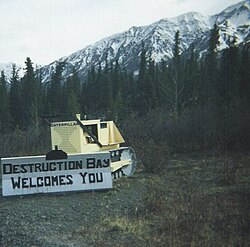This article includes a list of general references, but it lacks sufficient corresponding inline citations .(July 2015) |
Destruction Bay | |
|---|---|
 Welcome sign made on an old bulldozer | |
| Coordinates: 61°15′15″N138°48′24″W / 61.25417°N 138.80667°W | |
| Country | Canada |
| Territory | Yukon |
| Area | |
| • Land | 13.57 km2 (5.24 sq mi) |
| Population (2016) [1] | |
• Total | 55 |
| • Density | 4.1/km2 (11/sq mi) |
| Time zone | UTC−07:00 (MST) |
Destruction Bay is a small community on the Alaska Highway (historical mile 1083) in Canada's Yukon on Kluane Lake.
Contents
Populated mostly by non-aboriginal residents, community residents provide Yukon government services to residents in the area (school, highway maintenance), including nearby Burwash Landing and some tourism-related businesses along the Alaska Highway. The name is derived from the wind blowing down structures erected by the military during highway construction in 1942–43.
The community has a school with three classrooms serving kindergarten through grade eight.
